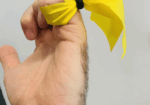What is Chronic Exertional Compartment Syndrome? Overview and Hand Therapy Treatment Ideas
Filed under Evaluation
Compartment syndrome is a condition characterized by increased pressure within a compartment of the body, leading to pain, swelling, and reduced tissue perfusion (Barkay et al., 2021; Buerba et al., 2019). It can be either acute or chronic (Barkay et al., 2021). Chronic exertional compartment syndrome (CECS) is a rare type, most commonly observed in athletes, particularly rowers and motorcyclists when the upper extremity is involved, though it can occur in anyone (Buerba et al., 2019; Cole et al., 2017). CECS is characterized by a gradual and reversible buildup of pressure within the compartment, leading to progressive pain and edema, typically triggered by activity. This occurs due to muscle hypertrophy, microtraumas, and a noncompliant fascia (Buerba et al., 2019; Ogrodnik et al., 2021). Patients often report persistent pain that worsens with repetitive movements (Cole et al., 2017).
Treatment Options for CECS
CECS is often managed conservatively, though surgical options are available if symptoms persist and interfere with daily activities.
Conservative Treatments
Conservative management typically includes massage, stretching, and activity modification (Buerba et al., 2019).
Manual therapy:
For massage and stretching techniques, a five-week course of a massage regimen and stretching home exercise program is found to decrease post-exercise pain (Blackman et al., 1998). A study concluded this is due to increased compartmental volume post massage due to fascial stretching, or due to individuals’ increased pain thresholds due to neural receptor alterations in the fascia or muscle changes (Blackman et al., 1998).
Biofeedback:
A way to treat this syndrome is to provide activity modification education. Furthermore, chronic compartment syndrome is often referred to as chronic exertional compartment syndrome because it is typically exercise induced (Buerba et al., 2019). This is achieved through providing biofeedback during activity modification and retraining interventions (M. Materi, personal communication, September 14, 2023; Zimmerman et al., 2017). Biofeedback provides visual feedback concerning the force a muscle compartment is exerting (Larsen et al., 2014; M. Materi, personal communication, September 14, 2023).
Figure 1: mTrigger biofeedback device Figure 2: mTrigger biofeedback device
https://www.mtrigger.com/biofeedback-occupational-hand-therapy/

Grips:
Furthermore, larger handles would help activity modification (M. Materi, personal communication, September 14, 2023). Since chronic exertional compartment syndrome is typically seen in rowers and motorcyclists which are occupations that demand high grip strength and continued use, creating larger grips could modulate the grip strength required to handle an object (Buerba et al., 2019; M. Materi, personal communication, September 14, 2023; Sheerin et al., 2023). Changing grip handles will change the amount of force and positioning a patient exerts into an activity which will change the repetitive motion they have been utilizing (M. Materi, personal communication, September 14, 2023; Zimmerman et al., 2017; Schubert, 2011).
Figure 2: Built up handle

Overall, chronic exertional compartment syndrome can be treated conservatively, but individuals have the option of undergoing a fasciotomy if symptoms persist that interfere with their everyday living.
References
Barkay, G., Zabatani, A., Menachem, S., Yaffe, B., & Arami, A. (2021). Acute compartment syndrome of the upper extremity: Clinical outcomes following surgical treatment. A retrospective cohort study. The Israel Medical Association Journal, 23(8), 516–520.
Blackman, P. G., Simmons, L. R., & Crossley, K. M. (1998). Treatment of chronic exertional anterior compartment syndrome with massage: A pilot study. Clinical Journal of Sports Medicine, 8(1), 14–17. https://doi.org/
Buerba, R. A., Fretes, N. F., Devana, S. K., & Beck, J. J. (2019). Chronic exertional compartment syndrome: Current management strategies. Open Access Journal of Sports Medicine, 2019(10), 71–79.
Cole, A., Hiatt, J. L., Arnold, C., Sites, T., & Ylanon, R. (2017). Chronic exertional compartment syndrome in the forearm of a collegiate softball pitcher. Sports Medicine – Open, 3(1), 11.
Larsen, C. M., Juul-Kristensen, B., Olsen, H. B., Holtermann, A., & Søgaard, K. (2014). Selective activation of intra-muscular compartments within the trapezius muscle in subjects with subacromial impingement syndrome. A case-control study.Journal of Electromyography and Kinesiology,24(1), 58–64.
Ogrodnik, J., Oliver, J. D., Cani, D., Boczar, D., Huayllani, M. T., Restrepo, D. J., Sisti, A., Manrique, O. J., Broer, P. N., & Forte, A. J. (2021). Clinical case of acute non-traumatic hand compartment syndrome and systematic review for the upper extremity. Hand, 16(3), 285–291.
Schubert, A.G. (2011). Exertional compartment syndrome: Review of the literature and proposed rehabilitation guidelines following surgical release. International Journal of Sports Physical Therapy, 6(2), 126–141.
Sheerin, M., O’Riordan, C., Conneely, M., Carey, L., Ryan, D., Galvin, R., & Morrissey, A. M. (2023). Effectiveness of occupational therapy interventions on function and occupational performance among adults with conditions of the hand, wrist, and forearm: A systematic review and meta-analysis. Australian Occupational Therapy Journal, 1-15.
Zimmermann, W. O., Linschoten, C. W., & Beutler, A. (2017). Gait retraining as part of the treatment programme for soldiers with exercise-related leg pain: Preliminary clinical experiences and retention. South African Journal of Sports Medicine, 29(1), 1-6.
More To Read
Why Burnout Happens in Hand Therapy and What We Can Do About It.
Why Burnout Happens in Hand Therapy There are several reasons why burnout can occur, this is especially true for healthcare workers. What We Can Do About It Final Thought:Burnout isn’t a personal failure, it is often a systemic issue. But we do have power over how we respond. As hand therapists, we are experts at…
Read MoreHand Therapy Interventions for Distal Upper Extremity Injuries and Conditions
Takata, S.C., Wade, E.T., & Roll, S.C. (2019). Hand therapy interventions, outcomes, and diagnoses evaluated over the last 10 years: A mapping review linking research to practice. Journal of Hand Therapy, 32(1), 1–9. Written by Brittany Carrie The Skinny Approximately 26.9% of orthopedic injuries and disorders of the upper extremity occur worldwide. Injuries are most…
Read MoreTop 6 treatments for Pinky Fractures
Clients who have experienced a fracture of the finger or hand often find it difficult to participate in meaningful occupations. Everyday tasks from grasping items, cutting food, taking lids off containers, turning keys, and many others can be very painful. Pinky fracture is particularly challenging and painful. This is typical because the largest contributor to…
Read MoreWrist Proprioception Ideas for Hand Therapy
Wrist Proprioception Intervention Ideas: By Ammie Ingwaldson Lack of wrist proprioception exercises can affect clients in the hand therapy setting with neurological and musculoskeletal conditions. Proprioception limitations are found in common conditions such as carpal tunnel syndrome, distal radius fracture, and CRPS (Valdes, Naughton & Algar, 2014). Proprioception is necessary during daily tasks to provide…
Read MoreSign-up to Get Updates Straight to Your Inbox!
Sign up with us and we will send you regular blog posts on everything hand therapy, notices every time we upload new videos and tutorials, along with handout, protocols, and other useful information.






